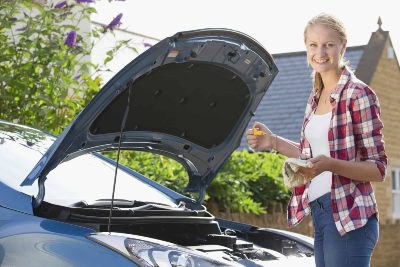The summer heat can do a number on your vehicle, and the data shows that the summertime is among the most dangerous times to drive. We assume we’re safer because there’s no snow and ice, but the NHTSA reports that July and August are high-fatality months for drivers.
How Does the Summer Heat Affect Your Vehicle?
Several common components and systems within your vehicle are directly affected by increasing summer temperatures:
Battery
You may have always thought that vibrations were the worst enemy of your vehicle battery, but excessive heat is another. Why? The heat causes the fluids within a typical 12-volt battery to evaporate away. The battery, however, is a closed system, so where does that evaporating fluid go? It stays within the battery mostly and causes internal structural damage.
Engine
The vehicle engine is always at a greater risk of overheating during the summer months. Whether it’s from lack of oil or coolant or a lack of cool-enough air rushing in, an overheating engine is always bad news and can result in some pretty expensive repairs if left unchecked.
Fluids
All of your vehicle’s critical fluids – oil, coolant, transmission fluid, brake fluid – can be adversely impacted by excessive heat. Their decreasing viscosity in heat is a problem and ultimately changes the fluid’s efficacy, especially in engine oil. Evaporation is also a danger, which reduces fluid levels to the point where they cannot perform their function within your engine. Fluid’ levels and conditions are critical to engine health.
Tires
Heat causes the air in your tires to expand, thus increasing overall tire pressure. If you are someone who tends to keep their tire pressure at the recommended psi or slightly over, this can mean your tires become at greater risk of a blowout. Excessive heat also dries the tires, which can cause deterioration in the rubber and even cracking in the side walls. Any tire damage compromises the structural integrity and safety of your tires.
Cooling System
We mentioned before the dangers of low coolant levels in your vehicle. Coolant can also become contaminated over time. If it has been a long time since you last flushed the coolant in your vehicle, doing so this year before summer hits would be an opportune moment. Coolant can also be susceptible to boiling if the user doesn’t choose a suitable product for their climatic conditions. Another part of keeping things cool and working properly is your air filter and a/c system. They help keep things fresh and cool inside the vehicle and keep contaminants from dry, hot, and dusty weather out of the engine. Make sure your air filters are in good order before summer hits.
Windshield Wipers
The plastic components of your vehicle are all susceptible to the summer heat. One of the most exposed components of your vehicle is the windshield wipers, which spend most of the day sitting continuously on hot glass. The plastic and rubber that make these critical components work can dry out, soften, and weaken in extreme heat.
Steps to Take to Prevent Heat Damage to Your Vehicle
Knowing the dangers of the hot summer to your vehicle, the next stage is to take preventative steps to keep your vehicle, engine, and rest of its components safe.
1. Park/Store Your Vehicle Out of the Sun
The sun and its UV rays work against your vehicle in just about every way. UV rays attack the clear coat, the paint color, the dashboard, the seat upholstery and contribute to overheating and rendering your vehicle fluids less effective. The solution is to keep your vehicle out of the sun. Park in a garage overnight if you can, or perhaps under a protective cover if out on the street. If these options are unavailable, invest in a windshield sunshade with a reflective surface. These shades can deflect about 99 percent of the UV rays and reduce heat in the vehicle by 20-30 percent. When parking in public or downtown areas, favor underground or otherwise covered parking garages.
2. Keep Up With Regular Maintenance
Another key to avoiding summer damage is to keep up with all regular maintenance. Get your air, oil and other filters changed on time; check your belts, hoses, gaskets, and other critical components that can be adversely affected by high temperatures. Ensure that your A/C compressor and condenser are working properly and that your vehicle’s exhaust system isn’t blocked. All of this will keep air and fluids moving smoothly where they need to be to help prevent engine overheating.
3. Check on Fluid Levels and Condition
Oil needs to be smooth, glossy, and not too thin; transmission fluid should be smooth and free from grit and other debris; coolant levels in the radiator should be up to the recommended level as indicated in the radiator itself. If you are uncertain about any of your vehicle’s “essential fluids,” then you should consult a mechanic to check on them for you as part of your vehicle’s routine maintenance.
4. Keep One Eye on the Temperature Gauge
The engine temperature gauge will tell you if and when the engine is getting close to overheating. If you notice a spike in engine temperature, the safest thing to do is find a spot to pull over, pop your vehicle’s hood, and then wait several minutes for the engine to cool down. Never touch the engine while it’s too hot, and if it rapidly heats up again when you try to set off once more, pull over again and call for roadside assistance.
5. Don’t Overinflate Your Tires
Increased air pressure in your tires, not to mention the dry, gravelly, or gritty conditions of summer roads, are all bad news. You are more at risk than ever of a blowout. Check your tire pressure and ensure that it hasn’t gone over the recommended psi as indicated by your owner’s manual. If your vehicle has a tire pressure monitoring system, it should alert you of a problem with the psi levels.
6. Stock Your Vehicle with Water and an Emergency Kit
It’s critical to have a summer-optimized emergency kit in your car in case of a breakdown, accident, or weather emergency. Your kit should include a good supply of drinking water and energy drinks, sunscreen, and snacks, as well as the typical items for a roadside emergency kit in any season.
We're Here to Help
AAMCO has more than 50 years of experience diagnosing, servicing, and repairing more than 20 million vehicles. Customers rely on us for:
- Quality workmanship
- Expert Technicians
- Superior service
- Best warranty coverage available
- Trustworthy, honest service
AAMCO Centers of Southern California and surrounding areas represent trust, quality, and value. Call us today!

 Schedule Appointment
Schedule Appointment














